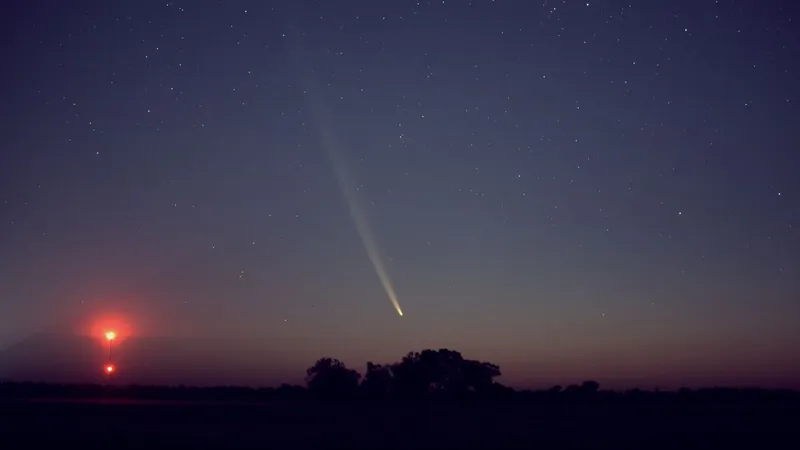
The Extraordinary Comet Tsuchinshan-ATLAS Lights Up the Night Sky: Your Ultimate Viewing Guide!
2024-10-08
Author: Emily
Get ready, stargazers! Comet Tsuchinshan-ATLAS is about to make a sensational debut as it reaches its peak brightness and slides into the evening sky.
As it transitions from September to October, observers have noted that the comet is shining brightly, boasting a dazzling starlike head and an impressive tail. Recent data from the Comet Observations Database (COBS) indicates the comet is currently between first and second magnitude—which means it’s brighter than most visible celestial objects.
To put its size into perspective, the coma—or the comet’s head—spans approximately 130,000 miles (209,000 kilometers) in diameter! Meanwhile, the tail stretches an astonishing 18 million miles (29 million km). Although it has primarily captivated viewers in the Southern Hemisphere until now, it's making its presence known across parts of the United States—sadly, still amidst the dawn twilight. Soon, an unforgettable view awaits those in the Northern Hemisphere as well!
The Best Days to Catch a Glimpse
The timing for comet enthusiasts couldn’t be more perfect! There are optimal viewing opportunities coming up: on the mornings of October 7 and 8—just 25 minutes before sunrise—and on the evenings of October 10 and 11—25 minutes after sunset. Because of its low altitude and the bright twilight, binoculars will give you the best chance to spot the comet initially.
For tech-savvy stargazers, telescopes equipped with GoTo mounts can pinpoint the comet using specific coordinates from NASA's Jet Propulsion Laboratory (JPL), where it is cataloged as C/2023 A3.
Daylight Sightings: Dangerous but Possible
Could Comet Tsuchinshan-ATLAS be bright enough to see during the day? Astrophysicist Joseph N. Marcus speculates that, owing to its unique orbital path between the Earth and the sun, viewers might experience a visual phenomenon known as forward-scattering, which can enhance the comet's brightness. He suggests it might brighten to as much as -5 magnitude—comparable to Venus—on October 9.
However, be cautious! Attempting to view a comet near the sun can be hazardous to your eyes. Experts warn against looking directly at the sun, as it can cause permanent damage to your vision. For safety, it's best to check out the comet through livestreams available on platforms like the Solar and Heliospheric Observatory (SOHO). This technology provides real-time views of the comet as it passes through the solar system.
Evening Splendor Awaits
As Comet Tsuchinshan-ATLAS shifts into the evening sky, it will truly shine between October 12 and 26, becoming the most prominent object visible beyond the moon. By October 12, sky watchers can begin to see the comet hovering roughly 6 degrees above the west-southwest horizon about 45 minutes after sunset, quickly brightening as it rises higher each night, setting approximately 90 minutes after sunset.
Dark Skies Yield the Best View
To witness this celestial wonder at its best, you’ll want to find a perfect viewing location away from city lights. The darker the sky, the clearer the views will be. While the moon may compete for attention in the early days of viewing, it will rise later each night, allowing for optimal comet visibility.
Watch for Tail Changes
As we approach October 12, the comet will be closest to Earth—approximately 43.9 million miles (70.7 million km) away—which may make its tail appear unusually short before it shifts direction. Fascinatingly, a rare phenomenon known as an “anti-tail” may also reveal itself—the result of Earth crossing the comet’s orbital plane and catching leftover dust particles illuminated by the sun.
By October 14, Comet Tsuchinshan-ATLAS will be located beautifully between Venus and the brilliant star, Arcturus, enhancing the evening’s stargazing experience. Daily sightings will reveal the comet climbing higher in the sky and setting later, providing breathtaking views.
A Limited Time Offer
As the month progresses, the comet’s brightness will naturally fade as it moves away from the sun and Earth. By October 26, it may only be as bright as a faint star. Nevertheless, viewers will witness a broad dust tail extending to significant lengths, offering a magical sight to behold before it disappears from our night sky.
Farewell, Comet Tsuchinshan-ATLAS
This is a rare opportunity to witness Comet Tsuchinshan-ATLAS as it travels from the Oort cloud—a region beyond our solar system that is believed to hold billions of comets. Though its orbital period remains uncertain, astronomers encourage enthusiasts to relish this unique experience as it graces our skies for possibly the last time.
So prepare your binoculars, find the perfect spot, and get ready to be dazzled by this cosmic visitor!









 Brasil (PT)
Brasil (PT)
 Canada (EN)
Canada (EN)
 Chile (ES)
Chile (ES)
 España (ES)
España (ES)
 France (FR)
France (FR)
 Hong Kong (EN)
Hong Kong (EN)
 Italia (IT)
Italia (IT)
 日本 (JA)
日本 (JA)
 Magyarország (HU)
Magyarország (HU)
 Norge (NO)
Norge (NO)
 Polska (PL)
Polska (PL)
 Schweiz (DE)
Schweiz (DE)
 Singapore (EN)
Singapore (EN)
 Sverige (SV)
Sverige (SV)
 Suomi (FI)
Suomi (FI)
 Türkiye (TR)
Türkiye (TR)